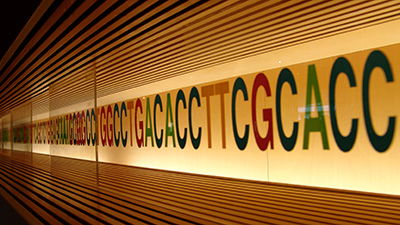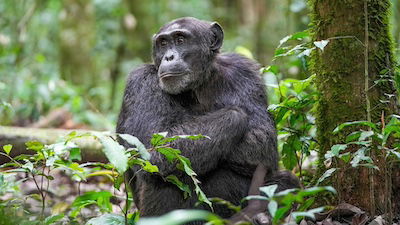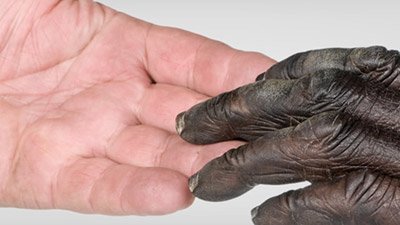
Chimp-Human DNA Similarity: What Does It Really Mean?
News to Know
Does genomic information show scientifically that Adam is not our collective ancestor?
News Source
- World: “Adam VersusCclaims from Genetics”
Claims that chimpanzee and human DNA are 96 to 99% identical are used by evolutionists as “proof” that chimps and humans are descended from a common ape-like ancestor. The Human Genome Project—according to the interpretations of evolutionists—scientifically disproved the possibility of all humans being descended from one man and one woman. But what does the science really demonstrate? Westminster Theological Journal recently published an informative essay by Westminster Theological Seminary professor Vern Poythress, who has a Th.D. as well as a Harvard Ph.D. in mathematics, refuting these claims.
The statistical similarity between chimp and human DNA relates primarily to the portions of DNA that code for proteins, ignoring the vast amount of DNA that has been commonly called “junk DNA,” sections that now appear to have regulatory and other functions. Furthermore, understanding how DNA is compared reveals the chimp-human similarity is not all it seems. DNA consists of millions of “bases”—four kinds of molecules that act like the letters in a code. But contrary to the impression given in television programs, sequencing DNA is not a matter of simply lining up long strings with millions of bases to see what matches.

The letters in this short sequence symbolizing a bit of DNA code stand for the bases: guanine, cytosine, adenine, and thymine. The sequence of such bases encode not only the instructions for the manufacture of all the proteins in a living organisms but the instructions regulating the use of those proteins and much more. Some sections of DNA strands being compared match like this, often because the same sorts of protein molecules are needed in living organisms. Because DNA consists of millions of bases, sequencing technology breaks it into short segments for comparison and then much match up the pieces to be compared, effectively ignoring the segments that differ greatly. Image by Westminster Theological Journal through World
As a result of technological limitations, comparisons between chimp and human DNA focus on areas that are similar. Thus, as Dr. Poythress explains, chimp and human DNA only appear “99%” identical if:
- repeated sequences are ignored
- only sections that “align naturally” are compared,
- and the only differences noted are single base-pair substitutions.
Thus, extra sequences of DNA—commonly called “insertions” and “deletions”—are ignored. When they are included among the differences, the figure becomes “96%.” Note that even these names—insertions and deletions—imply an assumption of evolutionary modifications by which the DNA of a common ancestor was gradually modified over time. But the science cannot look back to the genome of an imagined evolutionary ancestor. And a great deal of DNA, when chimps and humans are compared, simply does not correspond at all and is therefore completely absent from the oft-quoted statistics. Furthermore, despite evolutionary insistence that the chimp is our closest relative, gorilla and orangutan DNA is more similar to ours than chimpanzee is.
Furthermore, though not covered in Poythress’s essay, when the DNA sequences are compared more objectively without pre-selecting sequences and filtering the data, the chimp and human genomes are only about 70% similar.
Even more important than an awareness of the limitations on the statistical similarity between chimp and human DNA is the ability to understand how evolutionists interpret what genetic similarity there actually is. Biblical creationists understand that this is a consequence of having a common Designer who wisely designed humans and animals to function on earth. Poythress explains:
The most striking genetic similarities between humans and chimps lie in many of the protein coding regions within the DNA. That is understandable from the standpoint of design, because proteins are the backbone of chemical machinery inside a cell. Cells have to have machinery for metabolism, for cell division, for translating DNA into proteins, for dealing with toxins, and for responding to the environment. The machinery has to accomplish many of the same things in cells of many kinds, so it should not be surprising that there are similarities among proteins not only between man and chimpanzee but throughout the world of living things.
The notion that genetic similarities prove shared evolutionary ancestry is a consequence of naturalistic Darwinian assumptions superimposed on the data. Evolutionists assume chimps and humans share an evolutionary ancestry and interpret all data according to that assumption.

When sequences being compared differ by only a different base here and there, those variations are called “substitutions.” Image by Westminster Theological Journal through World.

When one stretch of the DNA being compared contains a sequence absent from the other, the difference is called an indel, meaning “insertion-deletion.” Implicit in the terminology is the assumption that the DNA of each diverged from a common ancestral form. Image by Westminster Theological Journal through World.
As Poythress says, “Darwinism says that all kinds of living things came into being by purely gradualistic processes. In the popular mind, and indeed also among many scientists, Darwinism also involves the additional assumption that the process of change over time was unguided and purposeless—in other words, God, if He exists, is absent.”
Yet nothing about the science can confirm that God did not act to create humans and animals as Genesis chapter one reports, without evolution. And nothing about the science can demonstrate the evolutionary claim that the origin of life was blindly naturalistic and purposeless. Poythress explains, “That claim overreaches the evidence and the competence of science. It is really a philosophical and religious claim.” Thus, atheism is a sort of “religion.”
Evolutionists assert that population genetics and molecular clocks cannot possibly point back to just two original people 6,000 years ago. Poythress points out that the calculations which this claim is based on assume that the human genome has always had constant rates of mutation and recombination. Population studies further depend on assumptions about the average lifespans of people. Yet Scripture indicates that lifespans changed dramatically after the global Flood. The notion that humanity could not have originated with two created people is rooted in unverifiable assumptions imposed upon the science.
Given the effects of sin’s curse on humanity, the dramatic changes in lifespan over a few thousand years, and the population bottleneck that occurred when the global Flood reduced the genomic variety in the human population to those genes in the eight people on the Ark, the uniformitarian assumptions on which evolutionary anthropologists and geneticists base their conclusions that the human population could not have been traced back to Adam and Eve are faulty.
Thus the science in no way “proves” human ancestry from an ape-like ancestor or the impossibility of human ancestry from Adam and Eve. As to the age of the earth, while Poythress writes nothing in his essay to suggest millions of years, in his opinion, the small variations (“gaps”) in the genealogical lists in the Old and New Testaments make it impossible to know how long ago God created man. However, a comparison of genealogical lists reveals that, while there are a few places where God chose to include and exclude certain people, only some genealogies contain information about time. And those lists, from which we (and Archbishop Ussher) derive calculations about the timeline of history, consist of numerically interlocked data rendering the inclusion or exclusion of a particular person—as far as the timeline goes—irrelevant. As Dr. Floyd Nolen Jones explains in Chronology of the Old Testament:
The Scripture precisely lists the age of each patriarch (i.e. Arphaxad = 35 years old) when the next patriarch (i.e. Salah) is born. Thus, even if the next patriarch in the recorded genealogy was a great-grandson rather than a son, this procedure of giving the age of one patriarch when the next is born fixes the two men’s lives relative to each other. In so doing, it provides an exact continuous chronology across this time span.1
The father’s (ancestor’s) name is mathematically interlocked to the chosen descendant; hence no gap of time or generation is possible.2
Furthermore, Jude 14 corroborates the Old Testament genealogies, informing us that Enoch was a member of the seventh generation from Adam. Scripture does not contradict itself. Biblical history therefore does reveal that God created Adam and Eve about 6,000 years ago. And the scientific evidence of hominid fossils, genomic analysis, and population studies only appear to “prove” evolution if the data are interpreted expressly by presuming evolution happened. Such reasoning is circular. Science does not disprove Scripture.
Further Reading
- Comprehensive Analysis of Chimpanzee and Human Chromosomes Reveals Average DNA Similarity of 70%
- If Human and Chimp DNA Are So Similar, Why Are There So Many Physical and Mental Differences Between Them?
- Are Humans and Chimps Related?
- Chimp Genome Sequence Very Different from Man
- Genome-Wide DNA Alignment Similarity (Identity) for 40,000 Chimpanzee DNA Sequences Queried against the Human Genome is 86–89%
- Response to Comments on “How Genomes are Sequenced and Why it Matters: Implications for Studies in Comparative Genomics of Humans and Chimpanzees”
For More Information: Get Answers
Remember, if you see a news story that might merit some attention, let us know about it! (Note: if the story originates from the Associated Press, FOX News, MSNBC, the New York Times, or another major national media outlet, we will most likely have already heard about it.) And thanks to all of our readers who have submitted great news tips to us. If you didn’t catch all the latest News to Know, why not take a look to see what you’ve missed?
(Please note that links will take you directly to the source. Answers in Genesis is not responsible for content on the websites to which we refer. For more information, please see our Privacy Policy.)
Footnotes
- Floyd Nolen Jones, Chronology of the Old Testament, (Green Forest, Arkansas: Master Books, 1993), 33.
- Ibid.

Answers in Genesis is an apologetics ministry, dedicated to helping Christians defend their faith and proclaim the good news of Jesus Christ.
- Customer Service 800.778.3390
- Available Monday–Friday | 9 AM–5 PM ET
- © 2026 Answers in Genesis



